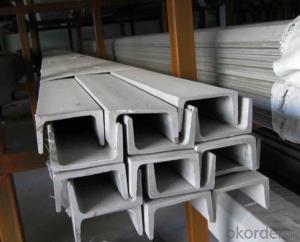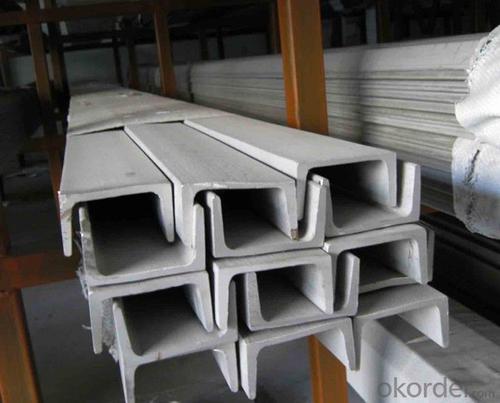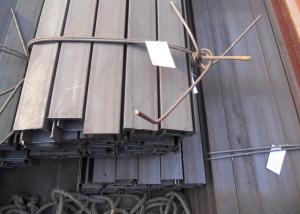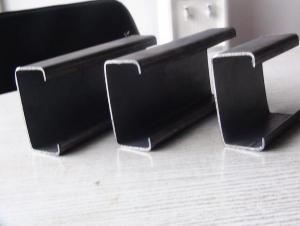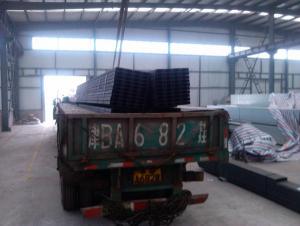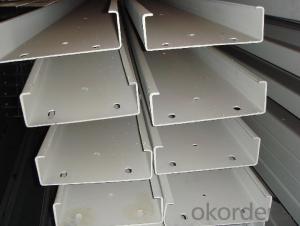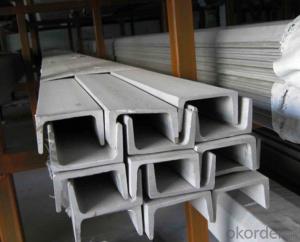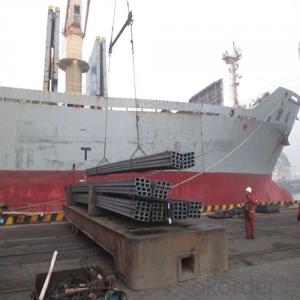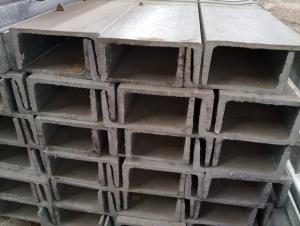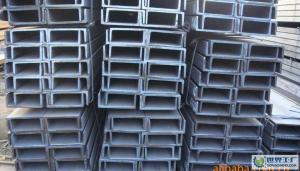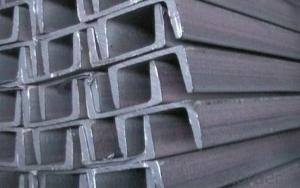JIS U CHANNEL HOT ROLLED HIGH QUALITY Q235
- Loading Port:
- Qingdao
- Payment Terms:
- TT OR LC
- Min Order Qty:
- 25 m.t.
- Supply Capability:
- 10000 m.t./month
OKorder Service Pledge
OKorder Financial Service
You Might Also Like
channel Details:
| Minimum Order Quantity: | Unit: | m.t. | Loading Port: | ||
| Supply Ability: | Payment Terms: | Package: | wire rod bundle |
Product Description:
Product Description:
Specifications of MS Channel:
1.We supply high quality MS Channel at reasonable price, including Chinese standard, Japanese standard and so on.
Standard | GB/JIS |
Material Grade | Q235,SS400 |
Technique: | Hot Rolled |
Sizes as per chinese standard: | 50*37*4.5mm - 300*89*11.5mm |
Sizes as per japanese standard: | 50*25*3mm – 200*80*7.5mm |
Length: | 6meter, 9meter, 12meter |
Note: 1.we are also competent to provide our customers other MS Channel based on other sizes according to customer’s requirements.
2. The length of our ms channel could be cut into other meters as per customer’s requirements. For example, the channel in 6meters could be cut into 5.8meters in order to be fit in the 20ft container.
2. The detailed sections of MS Channel as per GB standard.are shown in the table-1:
GB U CHANNEL | Standard | Sectional | Dimension |
| Mass: |
(mm) | (mm) | (mm) | (mm) | ||
50X37 | 50 | 37 | 4.50 | 7.0 | 5.438 |
63X40 | 63 | 40 | 4.80 | 7.5 | 6.634 |
80x43 | 80 | 43 | 5.00 | 8.0 | 8.045 |
100x48 | 100 | 48 | 5.30 | 8.5 | 10.007 |
120x53 | 120 | 53 | 5.50 | 9.0 | 12.059 |
140x58 | 140 | 58 | 6.00 | 9.5 | 14.535 |
140x60 | 140 | 60 | 8.00 | 9.5 | 16.733 |
160x63 | 160 | 63 | 6.50 | 10.0 | 17.240 |
160x65 | 160 | 65 | 8.50 | 10.0 | 19.752 |
180x68 | 180 | 68 | 7.00 | 10.5 | 20.174 |
180x70 | 180 | 70 | 9.00 | 10.5 | 23.000 |
200x73 | 200 | 73 | 7.00 | 11.0 | 22.637 |
200x75 | 200 | 75 | 9.00 | 11.0 | 25.777 |
220x77 | 220 | 77 | 7.00 | 11.5 | 24.999 |
220x79 | 220 | 79 | 9.00 | 11.5 | 28.453 |
250x78 | 250 | 78 | 7.00 | 12.0 | 27.410 |
250x80 | 250 | 80 | 9.00 | 12.0 | 31.335 |
250x82 | 250 | 82 | 11.00 | 12.0 | 35.260 |
280x82 | 280 | 82 | 7.50 | 12.5 | 31.427 |
280x84 | 280 | 84 | 9.50 | 12.5 | 35.823 |
280x86 | 280 | 86 | 11.50 | 12.5 | 40.219 |
300x85 | 300 | 85 | 7.50 | 13.5 | 34.463 |
300x87 | 300 | 87 | 9.50 | 13.5 | 39.173 |
300x89 | 300 | 89 | 11.50 | 13.5 | 43.883 |
Table-1
3. The chemical composition of HR Channel Steel according to Q235B is shown in Table-2.
Alloy No | Grade | Element(%) | ||||
C | Mn | S | P | Si | ||
Q235 | B | 0.12-0.20 | 0.3-0.7 | ≦0.045 | ≦0.045 | ≦0.3 |
Table-2
Note: we are able to present our customers relevant SGS test report for chemical composition of HR Channel Steel.
4. The mechanical property of HR Channel Steel according to Q235B is shown in Table-3-1 and Table-3-2
Alloy No | Grade | Yielding Strength Point(Mpa) | |||
Thickness(mm) | |||||
≦16 | >16-40 | >40-60 | >60-100 | ||
≧ | |||||
Q235 | B | 235 | 225 | 215 | 205 |
Table-3-1
Alloy No | Grade | Tensile Strength(Mpa) | Elongation After Fracture(%) | |||
Thickness(mm) | ||||||
≦16 | >16-40 | >40-60 | >60-100 | |||
≧ | ||||||
G235 | B | 375-500 | 26 | 25 | 24 | 23 |
Table-3-2
Note: we are able to present our customers relevant SGS test report for mechanical property of MS Channel as customer’s request.
Applications of MS Channel:
The MS Channel can be applied to construction of warehouses, workshops, sport stadiums and car parks etc.The hot rolled channel steel belongs to carbon structural steel which is applied to in the field of construction and machinery.In details, the hot rolled channel steel is usually used for arch-itechtural structure, and they could be welded in order to support or hang a vari-ety of facilities. They are also usually used in combination with I beam. Generally,the hot rolled channel steel we supply must possess perfect welding property, riveting property and mechanical property and so on.
Package & Delivery of MS Channel:
1.The hot rolled channel steel will be packed in bundle with steel wire at each end of every bundle and color marking in order to help the customer to recognize his goods more easily at sight.
2. And the hot rolled channel steel could be loaded into 20ft or 40ft container, or by bulk cargo.If the weight of each bundle reaches more than 3.5 mt, the loading by break bulk cargo should be choosed.When the weight of each bundle reaches less than 3mt, the loading by container should be choosed.
3.As for the transportaion from mill to loading port, the truck will be usually used. And the maximum quantity for each truck is 40mt.
4.All in all, we could do in accordance with customer's request
- Q: What are the different surface protection techniques for steel channels?
- To prevent corrosion and enhance the durability of steel channels, there are several surface protection techniques available. These techniques are as follows: 1. Galvanization: Applying a protective zinc coating to the steel channel serves as a sacrificial anode, creating a barrier against corrosion. Galvanized steel channels are highly resistant to rust and can withstand harsh environmental conditions. 2. Powder coating: The application of a dry powder to the steel channel, followed by heating, creates a durable and protective finish. This technique provides excellent resistance against corrosion, chemicals, and UV rays, while also offering a wide range of color options. 3. Epoxy coating: Epoxy coatings are suitable for steel channels exposed to chemicals or harsh environments. By applying a layer of epoxy resin, a protective barrier forms against corrosion, abrasion, and impact. 4. Paint coatings: Painting the steel channel with a layer of paint is a cost-effective surface protection method. The paint acts as a barrier, preventing moisture and oxygen from reaching the metal surface, thus reducing the risk of corrosion. Depending on specific requirements, different types of paints, such as acrylic, enamel, or epoxy, can be used. 5. Stainless steel cladding: This method involves covering the steel channel with a layer of stainless steel. Stainless steel is highly resistant to rust and oxidation, providing excellent corrosion resistance. Additionally, it offers a visually appealing and durable finish. 6. Hot-dip coating: Immersing the steel channel in a bath of molten zinc creates a thick and uniform zinc coating. This technique provides exceptional protection against corrosion and is commonly used in outdoor applications where the steel channel may be exposed to moisture, chemicals, or extreme temperatures. Each of these surface protection techniques has its own advantages and suitability for specific applications. The choice of technique depends on factors such as the environment, desired aesthetics, durability requirements, and budget considerations.
- Q: Are steel channels suitable for corrosive environments?
- Steel channels can be suitable for corrosive environments, depending on the specific conditions and the type of steel used. Stainless steel channels, for example, are highly resistant to corrosion due to their high chromium content. They can withstand exposure to moisture, chemicals, and other corrosive agents without deteriorating. However, carbon steel channels may not be as suitable for corrosive environments, as they are more vulnerable to rust and corrosion. In such cases, additional protective measures such as coatings or galvanization may be necessary to prevent corrosion. Ultimately, the suitability of steel channels for corrosive environments will depend on the specific application and the type of steel chosen. It is important to consult with experts or engineers to determine the best material for a particular corrosive environment.
- Q: Are steel channels suitable for use in the construction of platforms or raised floors?
- Yes, steel channels are suitable for use in the construction of platforms or raised floors. Steel channels provide excellent structural support, durability, and stability, making them ideal for constructing platforms and raised floors that need to withstand heavy loads and provide a safe and stable surface. Additionally, steel channels can be easily customized and installed to meet specific design requirements, making them a practical choice for such construction projects.
- Q: What are the different lengths available for steel channels?
- Steel channels are available in a variety of lengths to accommodate different construction and structural needs. The lengths can vary depending on the manufacturer and supplier, but common standard lengths for steel channels typically range from 20 feet to 40 feet. However, it is important to note that steel channels can also be custom cut to specific lengths to suit the requirements of a particular project. This flexibility in length options allows for greater versatility in construction applications, ensuring that steel channels can be used effectively in a wide range of projects.
- Q: Are steel channels suitable for overhead crane systems?
- Yes, steel channels are suitable for overhead crane systems. Steel channels are commonly used in the construction of overhead crane systems due to their strength, durability, and ability to support heavy loads. They provide a sturdy framework for the crane system and can be easily integrated into the design. Additionally, steel channels can be customized and adapted to meet the specific requirements of the crane system, such as the size, weight capacity, and span. Overall, steel channels offer the necessary structural support and stability needed for overhead crane systems.
- Q: What are the different types of connections used for steel channels?
- There are several different types of connections used for steel channels, including welded connections, bolted connections, and riveted connections. Welded connections involve joining the channels together using heat and a filler material, creating a strong and permanent bond. Bolted connections use bolts and nuts to secure the channels together, allowing for easy disassembly and reassembly if needed. Riveted connections involve using rivets to connect the channels, which provide a reliable and durable connection. The choice of connection type will depend on factors such as the load requirements, ease of installation, and the desired level of permanence.
- Q: What are the cost considerations when using steel channels?
- When utilizing steel channels, one must take into account various cost considerations. First and foremost, the price of the steel itself is a crucial factor. The cost of steel can fluctuate based on factors such as the steel's grade, quality, and market conditions. It is imperative to evaluate the cost of the steel channels in relation to the project's budget and overall expenses. Another consideration is the fabrication and installation of the steel channels. The costs associated with fabrication and installation can vary depending on the complexity of the design and the required specifications. It is vital to carefully assess these costs and ensure that they fall within the project's budget. Transportation costs should also be taken into account. Steel channels can be heavy and require special handling and transportation. The distance to the project site and the logistical aspects involved in transporting the steel channels can impact the overall cost. Maintenance and durability are also significant cost considerations. Steel channels are renowned for their durability and long lifespan, which can reduce maintenance and replacement costs over time. However, regular maintenance and appropriate care are still necessary to guarantee the longevity of the steel channels. Lastly, one must consider any additional costs associated with steel channels, such as coatings or finishes. Depending on the application and environmental conditions, specific coatings or finishes may be required to protect the steel from corrosion or other factors. These supplementary costs should be included in the overall budget. In conclusion, the cost considerations when employing steel channels encompass the cost of the steel itself, fabrication and installation costs, transportation costs, maintenance and durability, as well as any additional costs related to coatings or finishes. It is crucial to thoroughly assess these factors to ensure that the use of steel channels aligns with the project's budget and requirements.
- Q: How do steel channels perform under snow loads?
- Steel channels perform well under snow loads due to their high strength and stiffness. The structural integrity and load-bearing capacity of steel channels allow them to effectively resist the weight and pressure exerted by snow, making them a reliable choice for withstanding snow loads.
- Q: Can steel channels be used for signage structures?
- Signage structures can indeed utilize steel channels. These channels possess great strength and durability, rendering them appropriate for supporting hefty signage. It is also simple to fabricate and tailor them to meet specific design needs. What's more, steel channels can endure diverse weather conditions, such as strong winds and heavy rain, guaranteeing the longevity of the signage structure. Furthermore, they can be powder coated or painted to achieve the desired aesthetic, resulting in a professional and visually captivating appearance. In general, due to their strength, durability, and versatility, steel channels are widely trusted and favored when it comes to signage structures.
- Q: How do steel channels contribute to water management in construction?
- Water management in construction projects heavily relies on the utilization of steel channels. These channels serve as indispensable tools in establishing efficient drainage systems that effectively redirect and control the flow of water. A primary function of steel channels in water management involves providing a sturdy and trustworthy structure for channeling water away from construction sites. They are commonly employed to establish drainage ditches, culverts, or canals, which effectively prevent water accumulation and the possibility of flooding. Furthermore, steel channels are frequently used in the construction of stormwater management systems. These systems are designed to collect, store, and distribute rainwater in a highly effective manner, thereby reducing the risks associated with erosion and surface runoff. Steel channels can be employed to create channels or channels equipped with grates, which serve to collect rainwater and guide it towards designated storage areas or underground tanks. Moreover, steel channels play a significant role in the creation of retaining walls and barriers. These structures are crucial in preventing soil erosion and managing water runoff. By integrating steel channels into the design of these walls, water can be efficiently redirected, effectively preventing soil erosion and maintaining the structural integrity of the construction site. Additionally, steel channels can be utilized to establish efficient irrigation systems in construction projects. By strategically directing water to specific areas, these channels ensure an even distribution of water, minimizing wastage and optimizing plant growth. In essence, steel channels serve as vital components in water management during construction endeavors. Their durability, versatility, and reliability render them ideal for establishing drainage systems, stormwater management systems, retaining walls, and irrigation systems. Through effective water management, construction projects can effectively avoid potential damages, maintain a safe working environment, and ensure sustainable water usage.
Send your message to us
JIS U CHANNEL HOT ROLLED HIGH QUALITY Q235
- Loading Port:
- Qingdao
- Payment Terms:
- TT OR LC
- Min Order Qty:
- 25 m.t.
- Supply Capability:
- 10000 m.t./month
OKorder Service Pledge
OKorder Financial Service
Similar products
Hot products
Hot Searches
Related keywords
